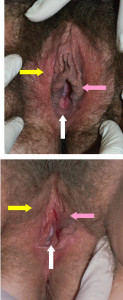Normal and Abnormal Vulvovaginal Symptoms
Each woman’s body is unique, including the vulva. Vaginal secretions and odor vary among women as well. Sometimes it’s difficult to figure out which characteristics are normal and which aren’t. Below is a summary of vulvovaginal characteristics and disorders that should help to clarify the difference. If you notice any abnormalities, it is important to consult your health care provider promptly and resist the temptation to self-treat.
Vaginal Discharge
Vaginal secretions result from multiple sources, including cells shed from the vaginal walls, mucus from the cervix and secretions of specialized glands (Bartholin’s and Skene’s), just to name a few. (5) Some vaginal discharge is normal and the amount changes with your hormonal status, e.g., it varies with different stages of the menstrual cycle. An increase in discharge occurs mid-cycle during ovulation and just afterwards. The color of discharge also changes during the menstrual cycle, ranging from clear to milky white or faintly yellow. If you take oral contraceptives, the amount of discharge does not vary over the course of the month, because the pills maintain steady levels of estrogen and progesterone in your body. Since the amount of discharge varies among women, it is important to become familiar with what is normal for you.
Vaginal discharge is mildly acidic, which helps to protect the vagina from infection. It is important to remember that normal secretions do not itch, burn, or irritate, nor do they smell like fish or ammonia. Abnormal discharge varies in amount and appearance. It can become more abundant, give off a strong odor, change in color (from clear to gray-white, yellow-white or yellow-green), or contain traces of blood, if inflammation is severe. (6)
Odor
The vulva contains a large number of sweat-producing glands. Sweat allows heat to escape and is a source of odor. Some vulvovaginal odor is normal, but if it’s unusually strong, it can be treated. Normal vaginal secretions may have an odor that changes over the menstrual cycle, not have an odor or smell faintly like sour milk. (7) Each woman has a unique scent. Vaginitis, or vaginal inflammation, is the most common reason for an unpleasant and abnormal odor. Bacterial Vaginosis (BV) is the likeliest suspect, because it elevates the normally acidic pH of the vagina, causing an odor of ammonia, in mild cases, or dead fish, in severe cases. Yeast is a less common cause of unpleasant odor, but may produce a sour-smelling or putrid scent. Trichomoniasis may also cause a fishy odor. (8)
Changes with Pregnancy and Childbirth
During pregnancy, vaginal secretions may increase considerably, be thicker in consistency and appear bluish-violet in color. If your discharge turns watery, it needs to be evaluated, because it is possible that the cervix has weakened, resulting in leakage from the water bag. (9) Some women also develop varicose veins in the vulvar area, which can be quite uncomfortable.
If you have a vaginal delivery, the vaginal canal will enlarge and the vaginal opening will look different afterwards. Also, if an episiotomy or tear occurs during delivery, you may have a visible perineal scar (below the vaginal opening). During the postpartum period, estrogen levels are very low, especially in women who breastfeed their babies, causing a decrease in vaginal lubrication. To protect the vulva in the weeks following delivery, providers advise women to abstain from sexual intercourse for at least four to six weeks.
Changes with Menopause
During the peri-menopause (three to five year period before menopause), you may experience vaginal dryness and/or itchiness, discomfort or pain with intercourse, and both urinary and vaginal infections. (10) Due to the lack of estrogen during menopause, vulvar skin usually becomes thinner and drier. Additionally, the labia minora may flatten or shrink and the vaginal opening appears smaller. Vaginal tissue may also become thin and dry, making intercourse uncomfortable or painful. (11) Eventually, discharge becomes minimal or disappears, except in women who take hormone replacement therapy, are heavy in weight, or take certain medications, such as tamoxifen. (12)
